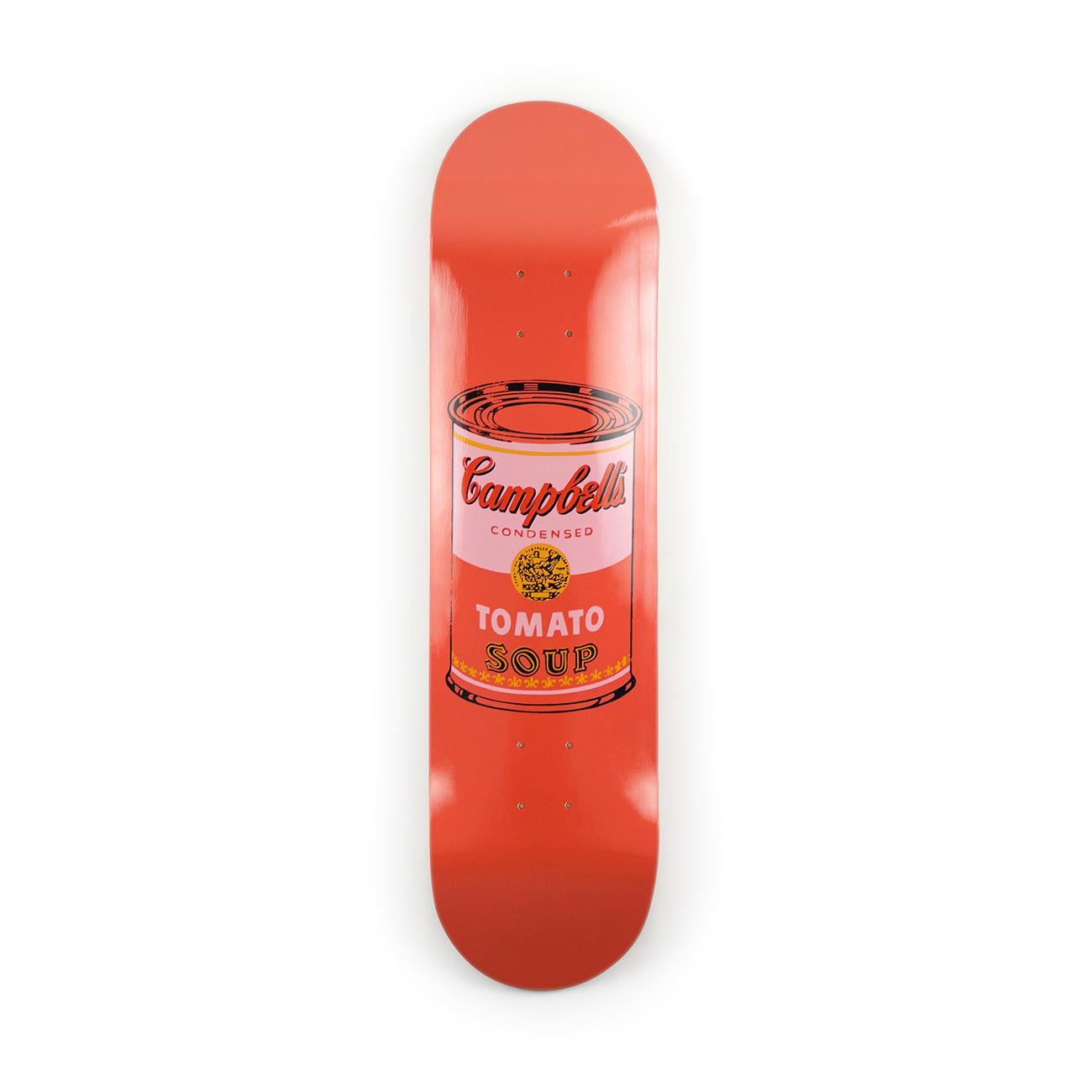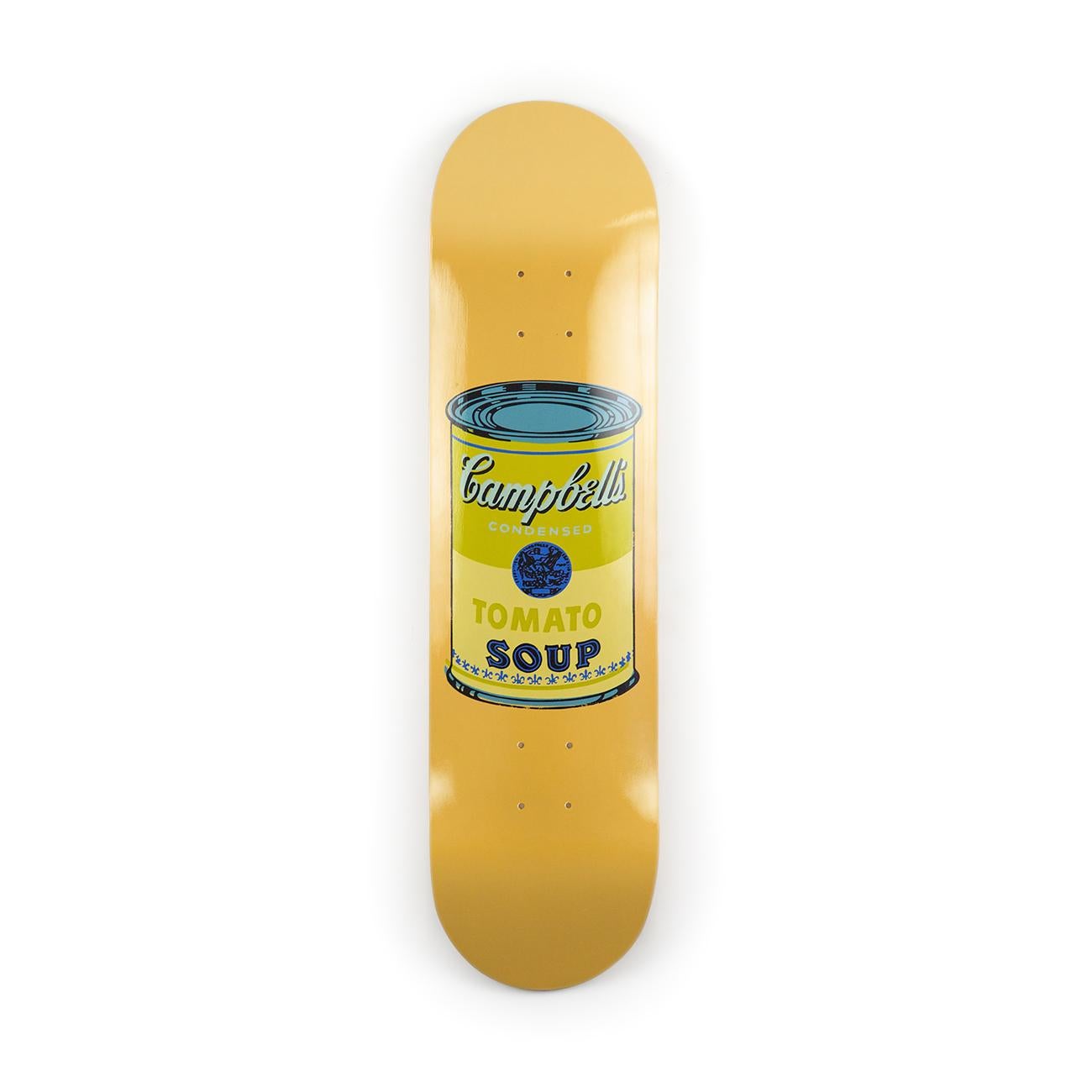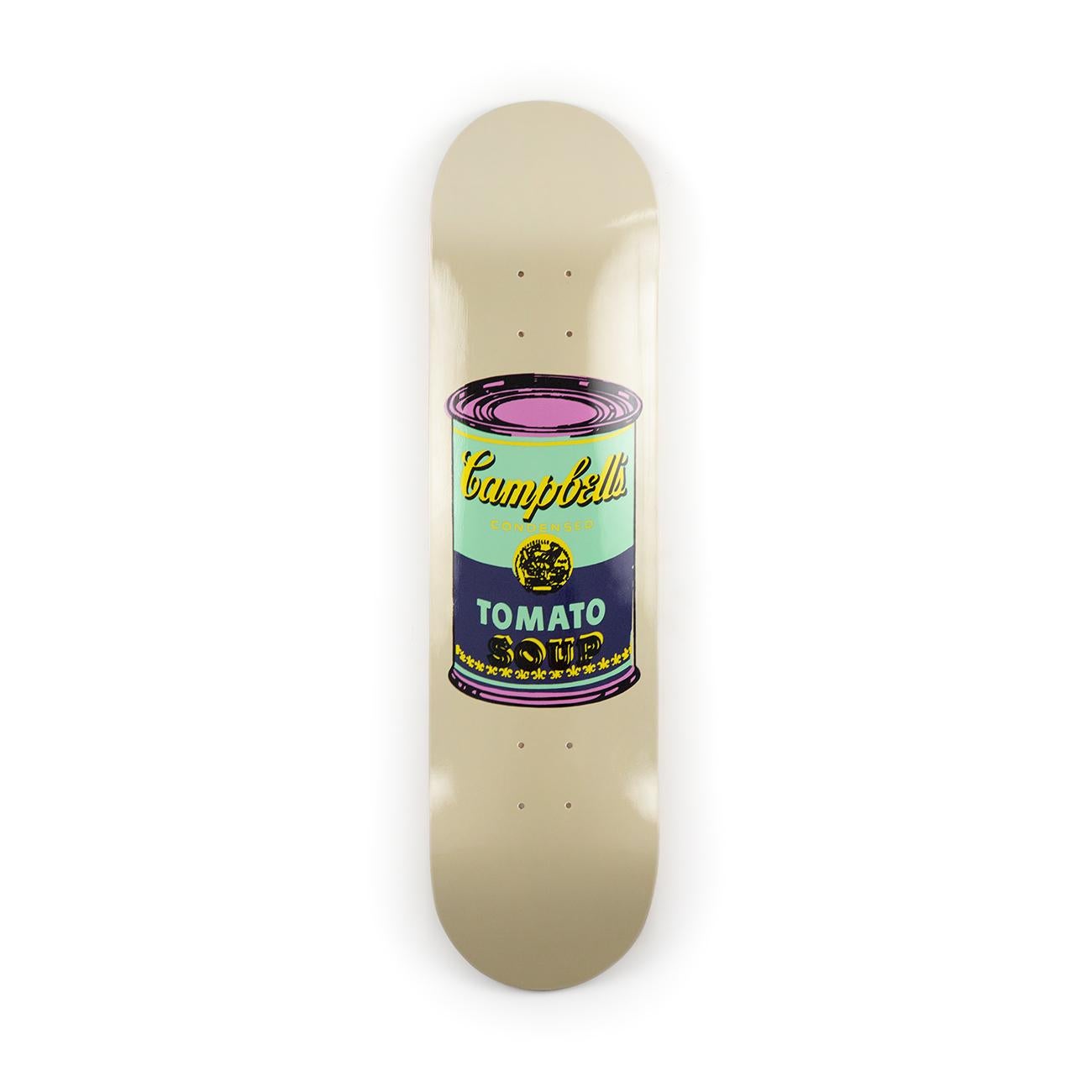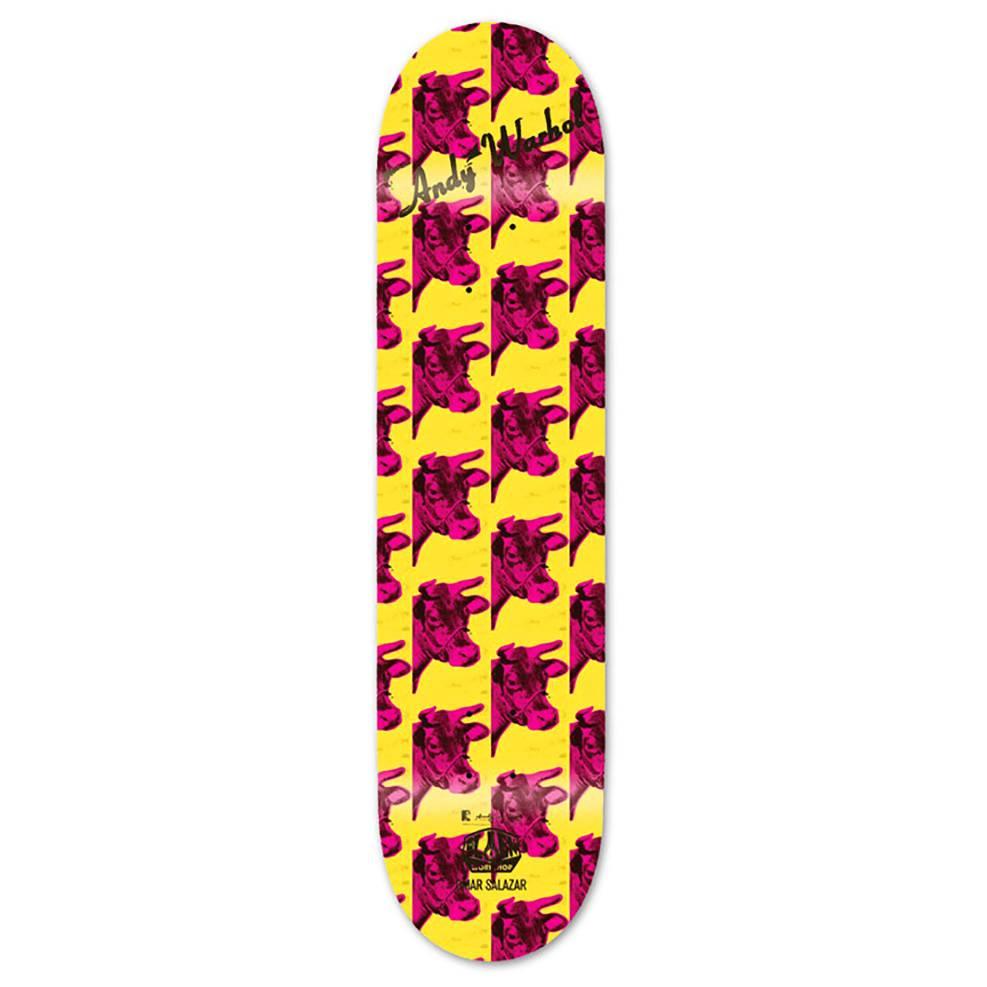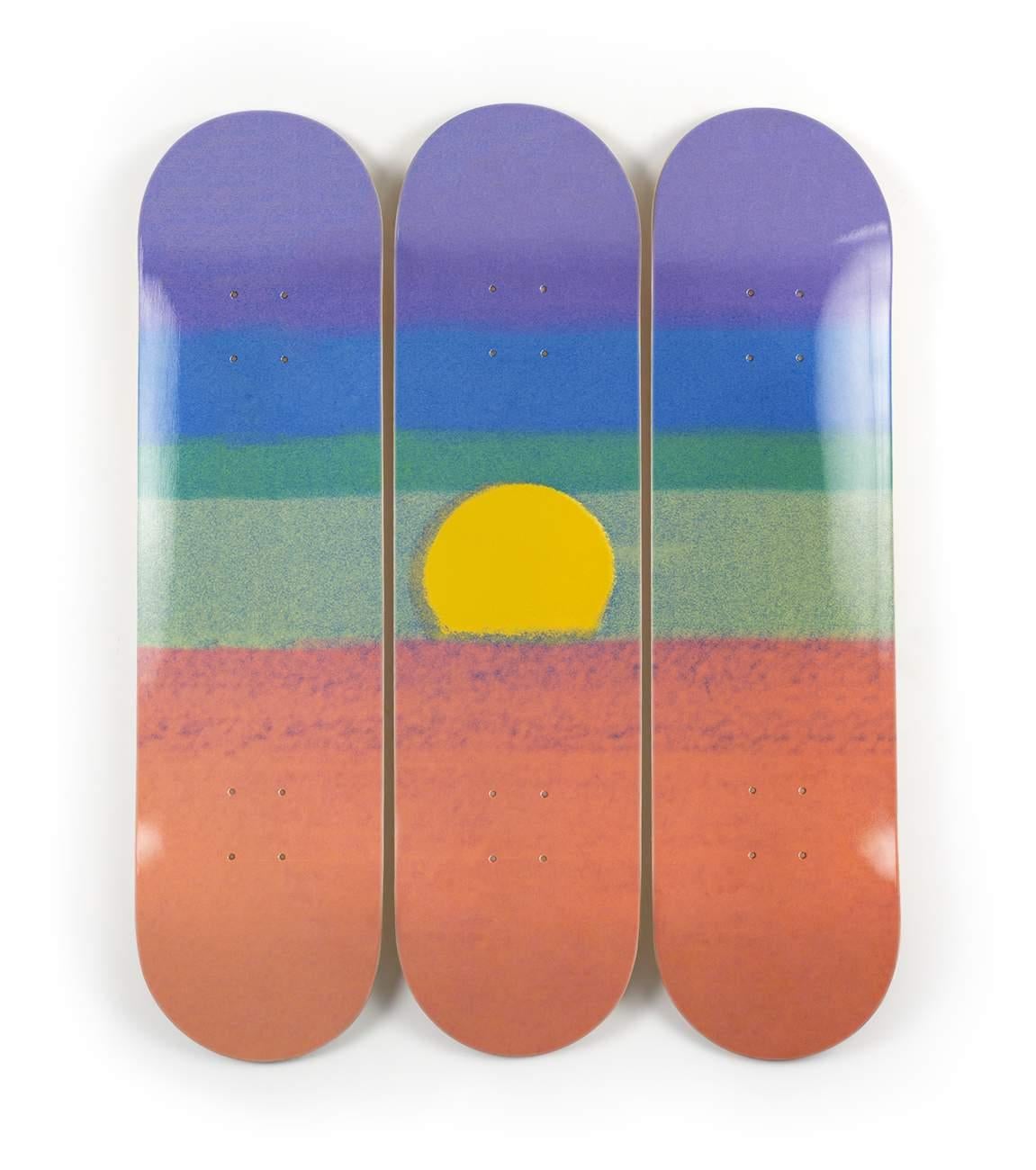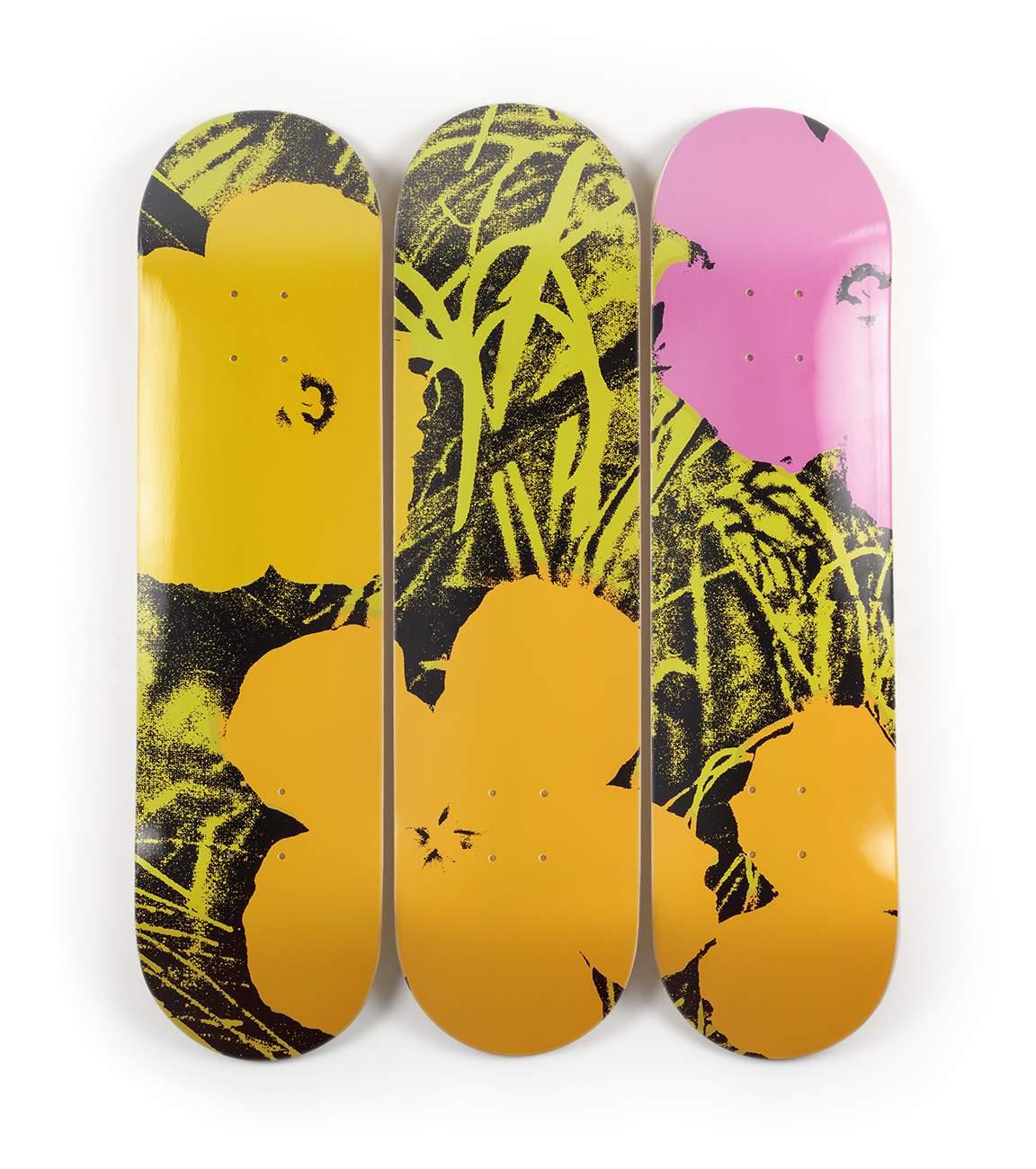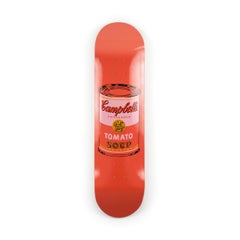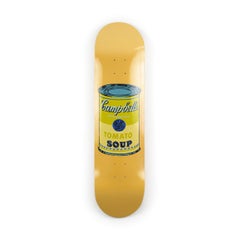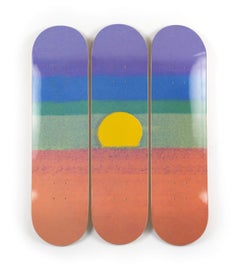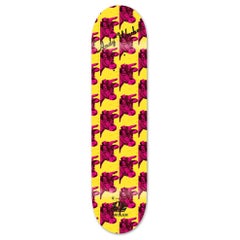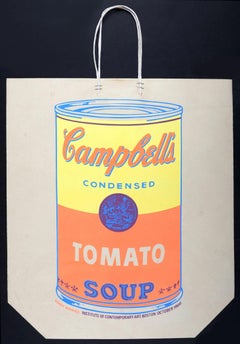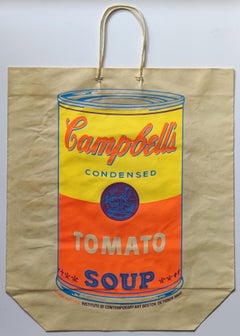Items Similar to ANDY WARHOL - COLORED CAMPBELL'S SOUP BLOOD Skate Deck Pop Art Modern Design
Want more images or videos?
Request additional images or videos from the seller
1 of 4
ANDY WARHOL - COLORED CAMPBELL'S SOUP BLOOD Skate Deck Pop Art Modern Design2019
2019
$387.96
£287.89
€325
CA$541.10
A$586.14
CHF 308.63
MX$7,114.55
NOK 3,848.97
SEK 3,639.11
DKK 2,474.74
About the Item
after Andy Warhol Colored Campbell's Soup - Blood
Date of creation: 2019
Medium: Digital print on Canadian maple wood
Size: 80 x 20 cm
Condition: In mint conditions and never displayed
This skate deck is made of 7 ply grade A Canadian maple wood. Top-print includes the official Andy Warhol brand logo.
Skateboard art edition under license.
©/®/™ The Andy Warhol Foundation for the Visual Arts, Inc.
Andy Warhol’s Colored Campbell’s Soup Cans series, created in 1965, consists of 32 canvases, each depicting the iconic Campbell’s Tomato Soup can. Originally, none of the individual works had their own title; they were only referenced by the variety of soup they represented. However, over time, each piece received a popular title based on its color composition, such as “Eggplant,” “Lemon,” or “Blueberry,” which further distanced the artwork from the everyday object and its original function.
These informal titles highlight the significance of color as a conceptual element. While the can remains recognizable, the unexpected colors alter perception, directing the viewer’s attention to aesthetic impact and visual experience rather than the object’s function. In this way, Warhol not only plays with repetition and familiarity but also transforms a banal product into an ambiguous symbol, inviting reflection on the relationship between appearance and meaning.
From a critical perspective, this approach shows how perception can change even when the textual content remains the same. The series reflects Warhol’s fascination with consumer culture and advertising, where colors are used to evoke emotions, create associations, and influence the way a product is perceived. Each color variation, with its informal title, acts as a playful and ironic commentary on the interplay between form, color, and message, demonstrating that imagery can influence perception even more than text.
Thus, the Colored Campbell’s Soup Cans series becomes far more than an aesthetic exercise: it is a reflection on how visual signs function in society, on the ambiguity between appearance and reality, and on the power of color to shape perception and expectation. Even in an everyday object, Warhol demonstrates that art can be playful, critical, and deeply aware of the consumer culture in which it exists.
ABOUT THE ARTIST
In 1949, Andy Warhol moved to New York City where he met Tina Fredericks, art editor of Glamour Magazine. Warhol's first jobs were doing drawings for Glamour, and women's shoes. During this time he also drew advertising for various magazines, including Vogue and Harper's Bazaar.
In 1952, he had his first solo exhibition at Hugo Gallery, in New York, where he exposed the of drawings he made to illustrate stories by Truman Capote. During 1953 to 1955, he worked for a theater group on the Lower East Side designing sets. Around those years he started to dye his hair silver.
In 1960, Warhol began to make his first paintings. Most of them were based on comic strips of Dick Tracy, Popeye, Superman, and Coca-Cola bottles. In 1962, Warhol made paintings of dollar bills and Campbell soup cans and those works were the ones he included in the exhibition The New Realists, at the Sidney Janis Gallery, in New York. In November of 1964, he rented a loft at 231 East 47th Street to make it his main studio, The Factory. In December, he began production of Red Jackie, the first of the Jackie series. In 1964, his first solo exhibition in Europe, held at the Galerie Ileana Sonnabend in Paris where Flowers series were exposed.
In 1965 the Institute of Contemporary Art, at the University of Pennsylvania held his first solo museum exhibition. During this year, he announced his retirement from painting, but he resume this activity again in 1972. During this time he met Lou Reed, John Cale, Sterling Morrison, and Maureen Tucker (collectively known as The Velvet Underground), and a German-born model turned chanteuse called Nico. This was an alliance that forever changed the face of world culture.
In 1968, Warhol's first solo European museum exhibition was held at Moderna Musset, Stockholm. That year on June 3, 1968, Warhol was shot by Valerie Solanas who was the founder of SCUM (Society for Cutting Up Men). Luckily, Warhol survived the assassination attempt after spending two months of recovery in the hospital.
During the 1970s and 80s, Andy Warhol's status as a media icon skyrocketed, and he used his influence to back many younger artists. He resumed painting in 1972, although it was primarily celebrity portraits. The Factory was moved to 860 Broadway. In 1976, he did the Skulls, and Hammer and Sickle series. Throughout the late 70s and 80s, a retrospective exhibition was held, as Warhol began work on the Reversals, Retrospectives, and Shadows series. The Myths series, Endangered Species series, and Ads series followed through the early and mid 1980s. On 22 February 1987, Andy Warhol died following complications from gallbladder surgery at eh age of 58 years old.
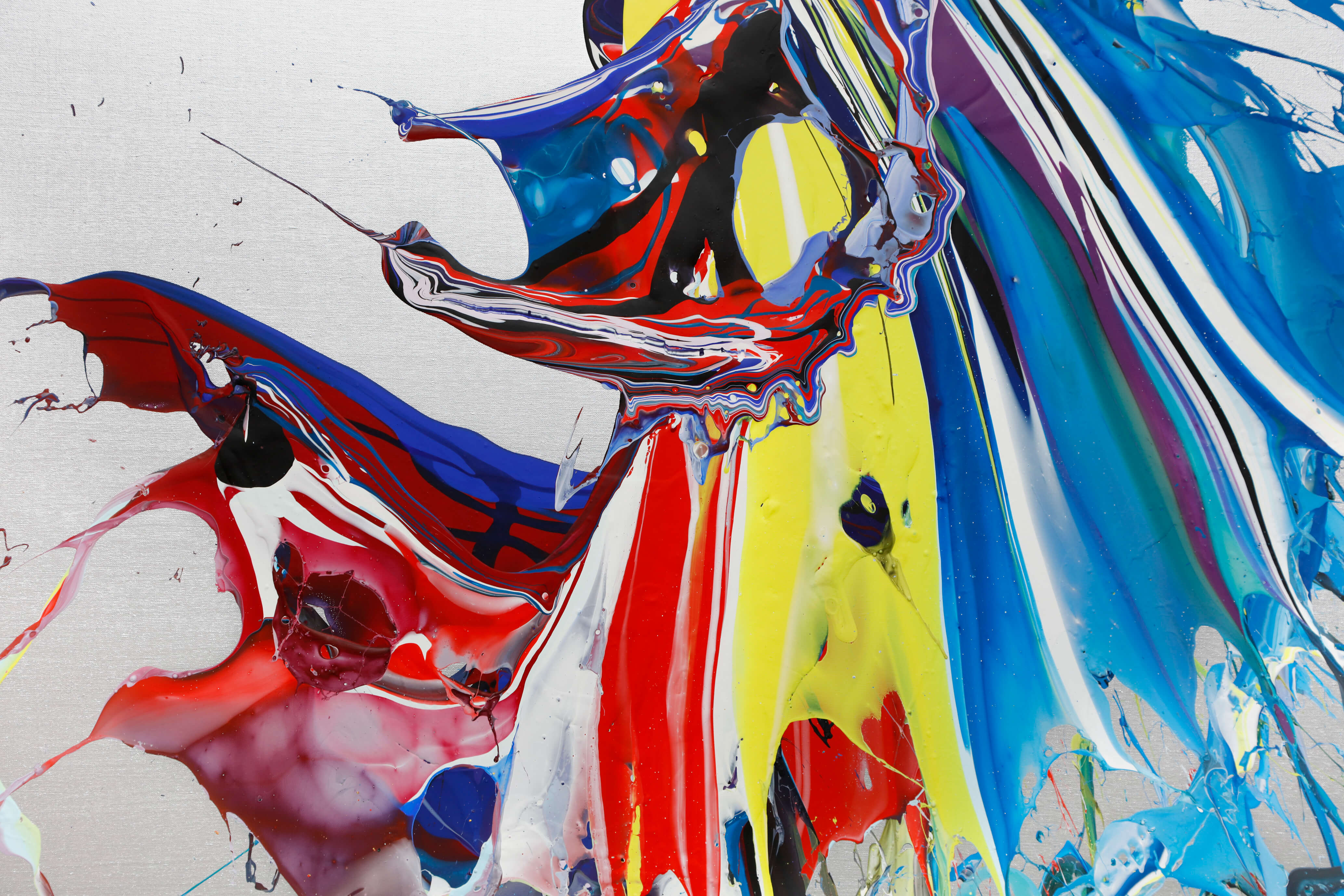
About the Seller
5.0
Gold Seller
Premium sellers maintaining a 4.3+ rating and 24-hour response times
Established in 2011
1stDibs seller since 2018
181 sales on 1stDibs
Typical response time: 13 hours
- ShippingRetrieving quote...Shipping from: Madrid, Spain
- Return Policy
Authenticity Guarantee
In the unlikely event there’s an issue with an item’s authenticity, contact us within 1 year for a full refund. DetailsMoney-Back Guarantee
If your item is not as described, is damaged in transit, or does not arrive, contact us within 7 days for a full refund. Details24-Hour Cancellation
You have a 24-hour grace period in which to reconsider your purchase, with no questions asked.Vetted Professional Sellers
Our world-class sellers must adhere to strict standards for service and quality, maintaining the integrity of our listings.Price-Match Guarantee
If you find that a seller listed the same item for a lower price elsewhere, we’ll match it.Trusted Global Delivery
Our best-in-class carrier network provides specialized shipping options worldwide, including custom delivery.More From This Seller
View AllANDY WARHOL - COLORED CAMPBELL'S SOUP PEACH Skate Deck Pop Art Modern Design
By Andy Warhol
Located in Madrid, Madrid
after Andy Warhol Colored Campbell's Soup - Peach
Date of creation: 2019
Medium: Digital print on Canadian maple wood
Size: 80 x 20 cm
Condition: In mint conditions and never display...
Category
2010s Pop Art More Art
Materials
Wood, Maple, Screen
ANDY WARHOL - COLORED CAMPBELL'S SOUP BEIGE Skate Deck Pop Art Modern Design
By Andy Warhol
Located in Madrid, Madrid
after Andy Warhol Colored Campbell's Soup - Beige
Date of creation: 2019
Medium: Digital print on Canadian maple wood
Size: 80 x 20 cm
Condition: In mint conditions and never display...
Category
2010s Pop Art More Art
Materials
Wood, Maple, Screen
ANDY WARHOL - COLORED CAMPBELL'S SOUP EGGPLANT Skate Deck Pop Art Modern Design
By Andy Warhol
Located in Madrid, Madrid
after Andy Warhol Colored Campbell's Soup - Eggplant
Date of creation: 2019
Medium: Digital print on Canadian maple wood
Size: 80 x 20 cm
Condition: In mint conditions and never disp...
Category
2010s Pop Art More Art
Materials
Wood, Maple, Screen
ANDY WARHOL SUNSET (ORANGE) Skate Deck Pop Art Modern Design
By Andy Warhol
Located in Madrid, Madrid
after Andy Warhol - SUNSET (ORANGE)
Date of creation: 2019
Medium: Digital print on Canadian maple wood
Edition: 500
Size: 80 x 20 cm (each skate)
Condition: In mint conditions and n...
Category
2010s Pop Art More Art
Materials
Wood, Maple
ANDY WARHOL - FLOWERS (LIME/ORANGE) Skate Deck Pop Art Modern Design
By Andy Warhol
Located in Madrid, Madrid
after Andy Warhol FLOWERS (LIME/ORANGE)
Date of creation: 2019
Medium: Digital print on Canadian maple wood
Edition: 500
Size: 80 x 20 cm (each skate)
Condition: In mint conditions a...
Category
2010s Pop Art More Art
Materials
Wood, Maple, Screen
JEAN-MICHEL BASQUIAT - In Italian. Skate Decks Pop Urban Art Design
By Jean-Michel Basquiat
Located in Madrid, Madrid
Jean-Michel Basquiat - In Italian
Date of creation: 2024
Medium: Digital print on Canadian maple wood
Edition: Open
Size: 80 x 20 cm (each skate)
Condition: In mint conditions and never displayed
This triptych is formed by three skate decks made of 7 ply grade A Canadian maple wood.
© Estate of Jean-Michel Basquiat. Licensed by Artestar, New York
In Italian (1983) is one of Jean-Michel Basquiat’s iconic works, created during a peak period of his artistic career. The piece reflects his distinctive style, blending graffiti, expressive brushwork, text, and symbolism. Like many of his paintings, "In Italian" presents a powerful and chaotic composition where words, figures, and signs interact in a raw and energetic visual language.
The title, In Italian, may suggest a reference to classical European culture—especially Italian Renaissance art—while at the same time subverting it through Basquiat’s urban, Afro-Caribbean perspective. His interest in contrasting high and low culture, refined and raw, is evident in this piece. The inclusion of text, often fragmented or cryptic, was one of Basquiat’s trademarks and serves here to provoke thought rather than deliver a clear message.
In this work, Basquiat explores themes such as identity, language, cultural heritage, and the appropriation of symbols. The figure depicted—alongside the textual elements—appears almost mythological or totemic, reinforcing Basquiat’s tendency to elevate marginalized characters into powerful, almost divine figures.
The brushstrokes are urgent, the colors bold, and the composition layered. It’s as if the viewer is meant to decipher a code—a mix of history, race, rebellion, and irony. Words in different languages, especially English and Italian, appear not to clarify meaning but to complicate it, suggesting the multilingual, multicultural environment Basquiat inhabited and commented on.
In Italian is a prime example of how Basquiat merged influences from the streets of New York with art history, African-American identity, and global culture. It's a bold visual statement that challenges traditional canons and forces the viewer to reconsider what art is, who gets to create it, and which voices are heard.
ABOUT THE ARTIST
Jean-Michel Basquiat (1960-1988) was one of the most influential artists of the 20th century, famous for his ability to fuse urban culture, social criticism and art history into a unique style. Born in Brooklyn, New York, to a Haitian father and Puerto Rican mother, his life and work were shaped by his multicultural heritage, the New York art scene and the social tensions of his time. Although his career was brief, his impact on contemporary art has been lasting and significant.
Basquiat showed an interest in art from an early age. His mother, Matilde Andrades, took him to museums and encouraged him to draw. At the age of seven, a car accident left him hospitalized for a time, and it was then that his mother gave him a copy of the anatomy book Gray's Anatomy, which influenced his fascination with the human body and its visual representation.
Despite his early talent, Basquiat's family life was turbulent. His mother was hospitalized for psychiatric problems and his relationship with his father, Gerard Basquiat, was troubled. This instability contributed to Basquiat dropping out of school at age 17 to pursue his artistic career on the streets of New York.
As a teenager, Basquiat joined the New York graffiti scene under the pseudonym SAMO (an acronym for "Same Old Shit"), which he used to sign his cryptic and poetic messages on the streets of Manhattan with his friend Al Diaz. SAMO's graffiti were a mixture of philosophical and social commentary on popular culture, capitalism and religion, and soon attracted the attention of the underground art scene.
In 1980, SAMO "died" when Basquiat and Diaz decided to end their collaboration, marking the beginning of Basquiat's transition from street graffiti to art galleries.
Basquiat emerged as a talent to watch in 1980, when he participated in the group exhibition The Times Square Show, which included other emerging artists from New York's Lower East Side scene. That same year, he attracted the attention of critics and collectors who saw in his work an electrifying blend of street art and neo-expressionism, the predominant movement of the time.
In 1981, art critic René Ricard published the influential essay The Radiant Child in Artforum magazine, which positioned Basquiat as one of the most promising artists of his generation. Shortly thereafter, he met renowned artist Andy Warhol, with whom he formed a close friendship and significant artistic collaboration. This association was instrumental in catapulting his career into the world of high art.
The collaboration with Warhol was a pivotal point in Basquiat's career. The two artists, although coming from very different worlds, shared a fascination with fame and popular culture. Together, they produced a series of works that combined Warhol's pop art icons with Basquiat's raw, spontaneous style.
However, this collaboration was also a source of controversy. Many critics accused Warhol of "exploiting" Basquiat, while others saw the collaboration as a creative dialogue between two genius minds. Although the criticism was mixed, there is no doubt that the relationship between the two artists helped cement Basquiat's reputation in the art world.
Basquiat's style is a unique amalgam of influences. His work is characterized by the use of dismembered human figures, skeletons and internal organs, evoking the fragility of the body and mortality. Basquiat also used symbols that alluded to African-American and African history, such as crowns, masks and references to historical figures such as Toussaint Louverture.
The use of text is another crucial aspect of his work. Words, phrases and numbers appeared in his paintings, often crossed out or overlapped, creating a sense of controlled chaos. These fragmented words provoked a non-linear reading of his works and conveyed multiple layers of meaning.
His art also reflected his concerns about racial issues, especially the place of people of African descent in Western art history and in society at large. The crowns that Basquiat often drew on his figures were a symbol of power and resistance, a way of proclaiming himself "king" in a world that had historically excluded black artists from the upper echelons of art.
In works such as The Death of Michael Stewart...
Category
2010s Pop Art More Art
Materials
Wood, Digital
You May Also Like
Andy Warhol Cow Skate Deck 2010
By (after) Andy Warhol
Located in NEW YORK, NY
Vintage Andy Warhol Cow Skateboard Deck:
This work originated circa 2010 as a result of the collaboration between Alien Workshop and the Andy Warhol Foundation. A brilliant piece of...
Category
1960s Pop Art More Art
Materials
Offset, Wood
Campbell's Soup Can (Tomato Soup)
By Andy Warhol
Located in New York, NY
Created by Andy Warhol in 1966 to coincide with an early exhibition of the artist’s work at the Institute of Contemporary Art in Boston, Campbell’s Soup Can...
Category
20th Century Pop Art Prints and Multiples
Materials
Screen
Price Upon Request
Andy Warhol Mao Skateboard Deck
By (after) Andy Warhol
Located in NEW YORK, NY
Rare Out of Print Andy Warhol Mao Skateboard Deck circa 2012.
A highly decorative estate licensed skate art piece which originated circa 2012 as a result of the collaboration betwe...
Category
21st Century and Contemporary Pop Art More Art
Materials
Wood
Andy Warhol -- Campbell's Soup Can (Tomato)
By Andy Warhol
Located in BRUCE, ACT
Andy Warhol
Campbell's Soup Can (Tomato), 1966
Screenprint in colors on shopping bag from an edition of an unknown size
Size 48.9 x 43.2 cm
Published by the Institute of Contemporary...
Category
1960s Prints and Multiples
Materials
Screen
Damien Hirst Supreme Skateboard Deck
By Damien Hirst
Located in NEW YORK, NY
Damien Hirst Spin Series Skate Deck, Supreme 2009
Medium: Screen print in colors on polychrome wood skateboard deck.
Excellent overal condition.
Dimensions: 31.1 x 7.68 in (78.99 x 19.51 cm).
Stamped signature and Supreme logo on reverse.
"Hirst first experimented with spin art in 1992 at his studio in Brixton (‘Beautiful Ray of Sunshine on a Rainy Day Painting and Beautiful Where Did All The Colour Go Painting’ (1992). The following year, he set up a spin art stall with fellow artist Angus Fairhurst at Joshua Compston’s artist led street fair, ‘A Féte Worse than Death’. Made up as clowns by performance artist Leigh Bowery, Fairhurst and Hirst invited visitors to pay £1 to create their own spin paintings to be signed by the pair, (and another £1 to drop their trousers and reveal their painted cocks and bollocks!)
The spin paintings are characterised by the works’ elongated titles, which begin with ‘Beautiful’ and end in ‘painting’, and their bright colours. The series began in earnest in 1994, when Hirst had a spin machine made whilst living in Berlin. A series of his machine-made spin drawings were subsequently exhibited at Bruno Brunnet Contemporary Fine Arts, Berlin, later that year. The exhibition ‘making beautiful drawings: an installation’, invited visitors to the gallery to make their own free drawings on a spin drawing machine made from a drill. The first Berlin-made spin painting exhibited was ‘Beautiful, pop, spinning ice creamy, whirling expanding painting’ (1995), at the Waddington Gallery, London, in 1995." (source: Damien Hirst site)
Related Categories:
Damien Hirst spin. Damien Hirst abstract. Damien Hirst skateboard...
Category
1990s Pop Art Prints and Multiples
Materials
Wood, Screen
Price Upon Request
Flowers (Lime/Orange) Skateboard Decks After Andy Warhol
By (after) Andy Warhol
Located in Jersey City, NJ
The Skateroom with the Andy Warhol Foundation
set of three-skateboard decks
7-ply Canadian Maplewood with screenprint
Measures: Each: 31 height x 8 inches
approx. 31 height x 24 inches when installed
mounting hardware included
edition of 500 (screen-printed signature)
The Andy Warhol Foundation for the Visual Arts, Inc.
This triptych includes three skateboard decks and comes ready to hang with mounting hardware and instructions. It is from a limited of 500 and each deck features a screenprint signature. A certificate of authenticity is also included.
Warhol's Flower series was a departure from his usual representation of brands which he was making at the time. The series is based on a photograph of hibiscus blossoms that he found in a magazine titled Modern Photography. According to art critic David Bourdon, Warhol’s vibrant manipulation of colors produces a floating effect in his flowers, “like cut-out gouaches by Matisse set...
Category
2010s Belgian Wall-mounted Sculptures
Materials
Maple
